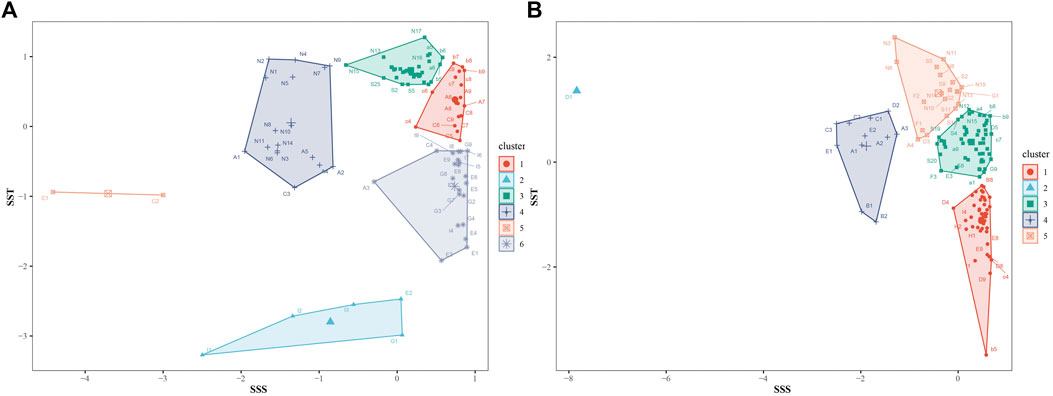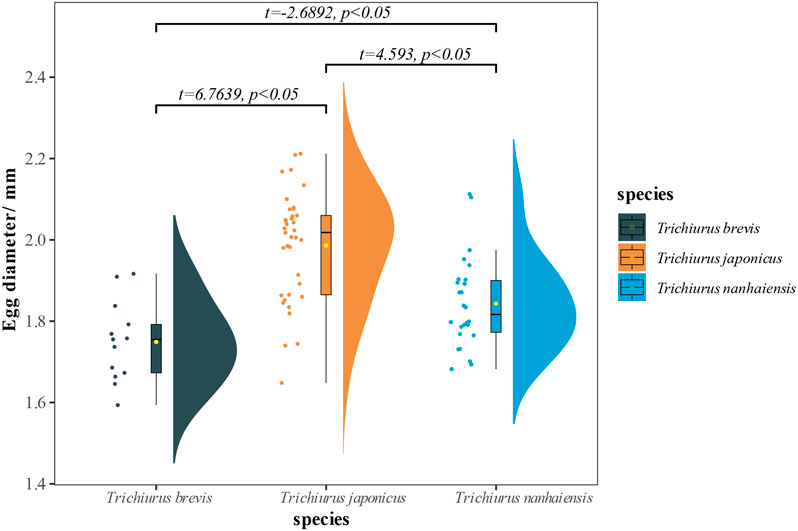- 1College of Fisheries, Guangdong Ocean University, Zhanjiang, China
- 2South China Sea Fisheries Research Institute, Chinese Academy of Fishery Science, Guangzhou, China
- 3Key Laboratory of Open-Sea Fishery Development, Ministry of Agriculture and Rural Affairs, Guangzhou, China
- 4Southern Marine Science and Engineering Guangdong Laboratory, Guangzhou, China
Commercially important hairtails, Trichiurus spp., are widely distributed throughout China’s marine waters. Because eggs of these species are difficult to identify and the taxonomy of the group has recently been resolved, their spawning grounds in the northern South China Sea (SCS) are not well known. We identified three Trichiurus species (T. japonicus, T. nanhaiensis, and T. brevis) using DNA barcodes in spring and late summer–autumn ichthyoplankton surveys of 2019 in the northern SCS. Egg distributions reveal that the spawning grounds of T. japonicus and T. nanhaiensis occur mainly from the central and southern Beibu Gulf, along Hainan Island, to the waters off the Pearl River Estuary, and that egg densities are higher in spring than in late summer-autumn. Spawning of T. japonicus commonly occurs along the continental shelf, T. nanhaiensis along the continental shelf to slope (over seabed depths of 42–380 m), and T. brevis mainly in shallow water. Considering the salinity and temperature data, we found that the eggs of Trichiurus were associated with specific water masses. In spring, eggs of T. japonicus and T. nanhaiensis occurred at central and southern Beibu Gulf water mass (CSBGWM) and South China Sea surface water mass (SCSWM). While in late summer-autumn, eggs of T. japonicus and T. nanhaiensis mainly occurred in the waters of SCSWM. Our findings reveal that the occurrence of Trichiurus eggs and their spatial and temporal distribution are determined by hydrological conditions.
Introduction
Hairtails, Trichiurus spp., also known as Cutlassfishes, are caught throughout China’s waters. These species are among the most important commercial fishes in China, the number one fishery in terms of catch, and the third most marine catches in the South China Sea (SCS) (China Agriculture Press, 1997-2019; Lu et al., 2008). The taxonomy of Trichiurus sp in the SCS has been long confused. Prior to the 1990s only one species [T. lepturus (synonym T. haumela)] was reported from this region. In the 1990s two additional species were recognised (T. nanhaiensis and T. brevis) (Wang, 1992; Wang, 1992). However, it is now widely accepted that two species that were once considered conspecific, T. japonicus and T. lepturus, are distinct (Wang, 1992; Wang, 1993; Wang et al., 1993; Wang et al., 1994; Chakraborty et al., 2006; Tzeng et al., 2007; Hsu et al., 2009; Tzeng and Chiu, 2012), brings to four the number of species now recognised from this region, in which T. lepturus is supposedly rare.
The importance of the hairtail fishery has resulted in considerable fisheries research effort being directed towards it (Ye and Rosenberg, 1991; Kwok and Ni, 1999; He et al., 2014; Wang et al., 2017). These fishes in the Bohai, Yellow Sea, East China Sea and South China Sea have all been overfished. To protect fish spawning stocks and juveniles, SCS fisheries were closed for 2 months in June and July from 1999 to 2008, and prolonged to 3.5 months in May and August from 2017 to now. Despite these efforts, there’s been little research on the early life stages and spawning of hairtail species (T. japonicus, T. nanhaiensis and T. brevis) in the SCS. Understanding early life stages of species is vital if recruitment is to be understood, and fisheries are to be managed (Chambers and Trippel, 1997; Fuiman, 2002; Checkley et al., 2009). More than 3,400 fish species—over 10.4% of the world fish species—occur in the SCS, which lies in the centre of 25 world biodiversity hotspots, surrounded by the Philippines, Wallacea, Sundaland, and Indo-Burma (Myers et al., 2000). The high diversity and low density of fishes in this region renders identification of adults and early life stages challenging.
The continental shelf of the northern SCS is a key habitat for nearly 1,500 fish species (Sun and Chen, 2013). This region is an important spawning and nursing ground for numerous fishes, such as hairtails, Golden threadfin bream, and Japanese scad (Zhang et al., 1985). Recent progress in understanding the reproductive biology and fishery ecology of these economic fishes has been made (Zhang et al., 1985; Chen et al., 2003; Yan et al., 2011; Shi et al., 2020). However, due to the difficulties identifying early life stages of fish, information of their spawning grounds based on ichthyoplankton surveys is limited in the SCS (Zhang et al., 1985; Zhou et al., 2011; Li et al., 2014; Chen et al., 2018).
DNA barcoding, an identification method using molecular maker (e.g., cytochrome c oxidase subunit I, COI), enables identification of fish eggs and larvae, regardless of their developmental stage or morphological plasticity (Valdez-Moreno et al., 2010; Frantine-Silva et al., 2015; Hubert et al., 2015). Many fish sequences (to June 2020, 21,800 + fish species, 342,000 + specimens) have been deposited in the BOLD (Barcode of Life Data System, http://www.barcodinglife.org, http://www.boldsystems.org) database (Ratnasingham and Hebert, 2007), which can be used to facilitate identification of both adult and larval fishes.
To identify spawning grounds of fishes in the northern SCS, we undertook ichthyoplankton surveys in the spring and late summer–autumn of 2019. Our aims were to: 1) differentiate eggs of Trichiurus species collected in these surveys using DNA barcodes, and to describe their morphology, 2) determine the spatial and temporal distribution patterns of eggs of Trichiurus species in the study period, and 3) analyse the hydrological conditions of spawning grounds of Trichiurus species. Our findings should contribute to improved management and conservation of these species and their spawning grounds in the northern SCS.
Materials and Methods
Sampling
Fish eggs were widely collected in the northern SCS (16.75–23.15°N, 107.25–117.21°E, Figure 1) during the spring (March–April) and late summer–autumn (August–October 2019). Eggs were collected with a 2.7 m long, 80 cm diameter zooplankton net, with a 0.505 mm mesh, and cod-end container of 400 μm. Nets were fitted with a General Oceanics flowmeter to estimate filtered water volume. In the represent study, two zooplankton nets were dragged simultaneously in horizontal trawls, and two vertical trawls were also conducted. For horizontal trawls, nets were dragged 10–15 min at 1.5–2.2 knots; for vertical trawls, nets were hauled from the bottom (if less than 200 m seabed depth) or from 200 m (if greater than 200 m seabed depth) to the surface at 1–1.5 m/s. The samples were preserved with one sample fixed in ∼75% ethanol/seawater, and the other sample in 5% formaldehyde solution/seawater. Temperature and salinity at different depths were recorded with a conductivity, temperature and depth (CTD) (SSTAML Plus X) from the surface to the near the bottom.
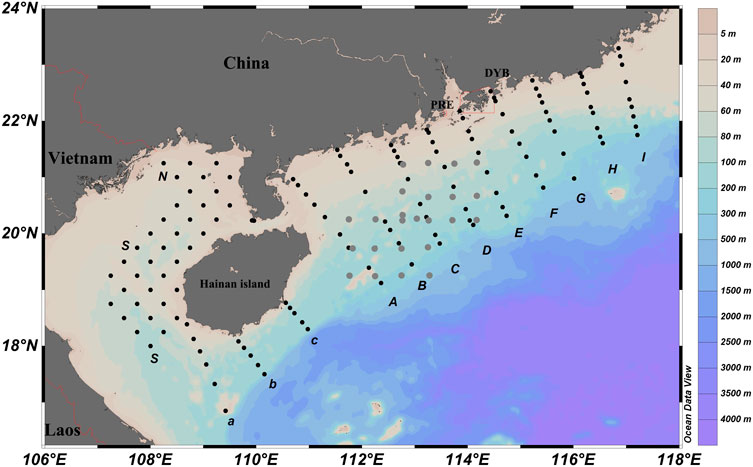
FIGURE 1. The sampling stations in northern South China Sea. The black dots indicated the horizontal stations; the gray dots indicated the horizontal and vertical stations. PRE, Pearl River Estuary; DYB, Daya Bay.
Egg Morphology
All eggs from each station were sorted under a stereomicroscope in a laboratory. If available, up to 15 eggs of different morphologies were randomly selected (when there were more than 15 eggs at a station, otherwise all eggs were selected), then photographed. Selected eggs were individually numbered, immersed in hydrogen peroxide for ∼8 min for cleaning and to rehydrate them so that their diameter was comparable to fresh eggs, and measured to 0.001 mm after being photographed using Zeiss microscope (Axioplan 2 imaging E). Their DNA was then extracted. Egg morphology descriptions follow Shao et al. (2002) and Ikeda et al. (2015). In the present study, pairwise t-test was used to analysis the difference among the egg diameters of genus Trichiurus species.
DNA Extraction and Polymerase Chain Reaction Amplification
Total genomic DNA was extracted from each numbered egg using an Axygen Genomic DNA Miniprep Kit (Axygen, Shanghai, China). COI sequences (∼648 p) were amplified and sequenced using universal primers FishF1 and FishR1 (Ward et al., 2005). The polymerase chain reaction (PCR) contained 20 µl Tsingke TM Master Mix, 1 μl of each primer (10 pmol), 1–10 μl template DNA, and 8–17 μl ddH2O (total template DNA + ddH2O = 18 μl) to make a total volume of 40 μl. PCR conditions were 94°C for 3 min, 35 cycles at 94°C for 30 s, 51°C for 30 s, 72°C for 1 min, and a final extension at 72°C for 10 min. Amplification products of PCR reactions were purified using 1% low-melting agarose electrophoresis and sequenced bidirectionally on an ABI 3730 XL DNA system following manufacturer protocols. High-quality DNA sequences were edited with MEGA v 6.0 (Tamura et al., 2013).
Sequence Analysis
Egg sequences were initially checked the tracer files and assembled by SEQMAN in Lasergene version 7.0 (DNASTAR Inc., Madison, WI, United States), and then delimited by Blast searches in BOLD (Barcode of Life Data system, http://www.boldsystems.org/). Sequences exceeding a 98% similarity and 2% genetic distance threshold with the nearest neighbour species were tagged with the taxon name using criteria of Hubert et al. (2015). Local and adjacent oceanic fish COI sequences of Trichiurus spp. were cited from reliable literatures for secondary analysis should the aforementioned criteria not be met (Hsu et al., 2009; Tzeng and Chiu, 2012; Chang et al., 2017; Hou et al., 2018). A neighbor-joining (NJ) tree was reconstructed to illustrate lineage diversity via phylogenetic topology, based on the Kimura 2-parameter model (K2P, Kimura, 1980) with 1,000 bootstrap replicates by MEGA v6.0 (Tamura et al., 2013). Genetic distance was also calculated in MEGA v6.0 based on K2P model.
Hydrological Characteristic and Egg Distribution Analysis
The temperature-salinity diagrams were conducted to analyse the water mass type in the study area (Liu et al., 2001; Lei et al., 2002; Zhu et al., 2019). Data View 4.5 (Schlitzer, R., http://odv.awi.de, 2015) was used to draw the contour maps of SST and SSS of CTD data in spring and later-summer-autumn surveys. In the present study, k-means clustering method was applied to classify the surface sea temperature (SST) and surface sea salinity (SSS), and analysis the relationship with the hydrological requirments and occurrence of Trichiurus eggs.
Trichiurus spp. egg catch rates per station are presented as numbers of eggs per 100 m3 of filtered water (flowmeter data). Catch rates at stations with Trichiurus eggs were plotted using Surfer (version 15.0, Golden Software Inc., Golden, CO, United States). As the incubation period of Trichiurus spp. egg is 74–80 h at 21–24°C, and higher water temperature can reduce the time of duration (Zhang et al., 1985). Thus, we supposed the occurrence locations of eggs can represent the spawning ground. The extent of the spawning ground of Trichiurus spp. was indicated by the egg distribution pattern, by using a confocal ellipse of the distribution area and the density at each station, and calculated as follows:
Where X and Y are the longitude and latitude of the station i, and the X and Y bars are the confocal of the ellipses. The estimation followed the description of Sokal and Rohlf (1995) and Kim et al. (2005).
Results
Hydrological Characteristics
The distinct seasonal variation of SST and SSS in spring and late-summer-autumn of 2019 is shown in Figure 2. In summary, the distributions of SST and SSS in spring were different from those in late-summer-autumn. In spring, the SST showed regular trends of northeastward reducing from the sea areas of mouth of Beibu Gulf to the coast of main land, and the lowest SST was occurred in the coastal area from Pearl River Estuary (PRE) eastward to Shantou sea areas (Figure 2). The SSS showed four different distributional regions, and the lowest SSS was detected in the southwest coast of the PRE. In addition, the salinity front was clearly detected from the PRE southwestward to the central waters of Beibu Gulf, indicating the river plume from PR spread over westward over the coast and continental shelf area (Figure 2). In late-summer-autumn, the SST in the study area increased significantly than that in spring, especially the coastal and offshore area of PRE. The lowest SST and high SSS was occurred in southeastern nearshore sea areas of Hainan island, indicating a coastal upwelling probably occurred in this sea area (Figure 2). The low SSS sea area was observed to form as an elongated river plume over the northern SCS shelf, and the salinity front was extend to the nearshore of Daya Bay and shifted northwardly to coastal water, which was affected by diluted water from PR (Figure 2).
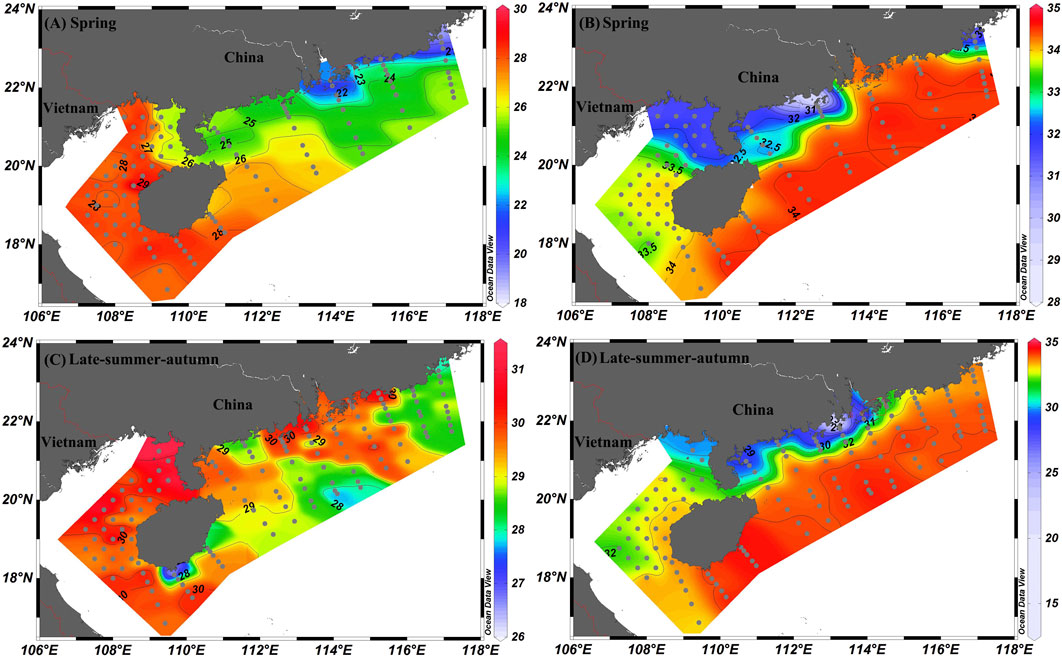
FIGURE 2. Spatial distribution of surface temperature [shading in °C, (A,C)], and salinity [shading in PSU, (B,D)] during spring and late-summer- autumn in 2019.
T-S diagrams were conducted to determine the water mass types. In summary, six categories of water masses were mainly detected in the study area in spring, i.e., two water masses in Beibu Gulf and four water masses in the east of Hainan island of northern SCS (Figure 3). The water masses in the Beibu Gulf is obviously different from those in east of Hainan island of northern SCS. In Late-summer-autumn, five categories of water masses were mainly detected in the study area (Figure 3). Northeastern Beibu Gulf water mass (NEBGWM) and eastern Guangdong coastal water mass (EGCWM) can be differentiated from other water masses. However, central and southern Beibu Gulf water mass (CSBGWM), South China Sea surface water mass (SCSWM) and Yuedong offshore water mass (YDFWM) mixed, indicating that the southwest monsoon in the SCS induced the high temperature of sea water in the region. In order to link the distributional pattern of fish eggs in horizontal trawls with water mass, k-means clustering analysis was used to group SSS and SST of CTD in each station. It indicated that six categories of potential water masses could be distinguished in spring (Figure 4A), and five categories of water masses in late summer-autumn (Figure 4B).
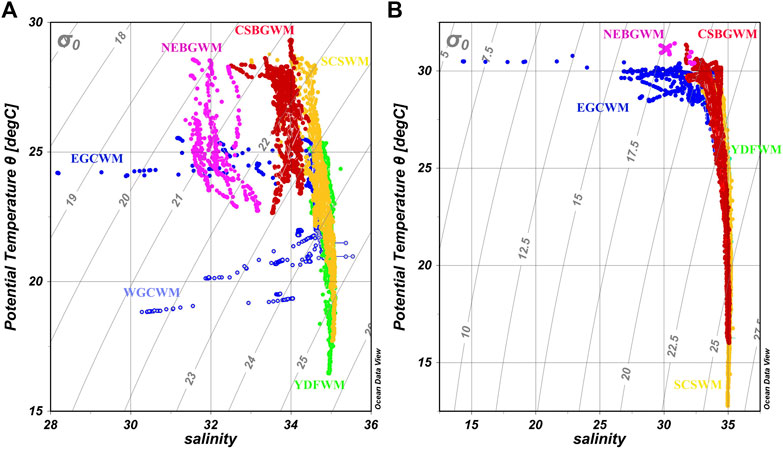
FIGURE 3. Potential temperature-salinity (T-S) diagrams in spring (A) and late-summer-autumn (B). The water masses are as follows: northeastern Beibu Gulf water mass (NEBGWM), central and southern Beibu Gulf water mass (CSBGWM), South China Sea surface water mass (SCSWM), western Guangdong coastal water mass (WGCWM), eastern Guangdong coastal water mass (EGCWM), and Yuedong offshore water mass (YDFWM).
Fish Eggs Delimitation by DNA Barcode
Of the successfully amplified and obtained good quality sequences, 76 sequences of 615 bp partial COI gene fragment (following alignment and trimming of noisy sites lacking apparent insertions/deletions and stop codons) were referred to Trichiurus spp. or Trichiuridae with 98% similarity and 2% genetic divergence among species after a blast search in BOLD; 75 sequences were 98–100% similar, with most nearest neighbours being 98.42–100% similar (one sequence was 96.5% similar). Both best match and nearest neighbour best match fell below thresholds, indicating samples were identifiable only to genus Trichiurus or family Trichiuridae (Supplementary Table S1). Secondary analysis combined our own and downloaded sequence data (Supplementary Table S2). A neighbour-joining tree of combined data produced three clusters supported by bootstrap values ≥99%, indicating individual clusters were single species (Supplementary Figure S1). In addition, average genetic distances within the three lineages were 0.007, 0.003 and 0.003, the eggs can be referred to T. japonicus, T. nanhaiensis and T. brevis, respectively.
Egg Morphology
Eggs of each species are pelagic, solitary, spherical, and have a smooth chorion and narrow perivitelline space (Figure 5, Supplementary Table S3). Their diameters ranged 1.65–2.21 mm, with the smallest (T. brevis) averaging 1.65–1.92 mm (n = 8; mean ± SE = 1.75 ± 0.09), and the largest (T. japonicus) averaging 1.65–2.21 mm (n = 37; mean ± SE = 1.986 ± 0.13). Egg diameters of T. nanhaiensis ranged 1.68–2.11 mm (n = 26; mean ± SE = 1.84 ± 0.11, Figure 6). The t-tests indicate that, among the egg diameters of three genus Trichiurus species, T. japonicus and T. nanhaiensis have a significant difference (t = 4.593,p<0.05), similarly, T. nanhaiensis and T. brevis (t = -2.6892,p<0.05), and T. japonicus and T. brevis (t = 6.7639,p<0.05). Oil globule shape was somewhat distorted, rendering diameter measurement difficult in developmental stages. Only diameters of regular oil globules were measured (0.29–0.57 mm), with the smallest (T. brevis) averaging 0.29–0.30 mm, distinct from those of T. japonicus (0.34–0.57 mm) and T. nanhaiensis (0.31–0.42 mm) (Supplementary Table S3). The diameter of the smallest oil globule and that of the egg differentiates of T. brevis from those of T. japonicus and T. nanhaiensis, but not the latter two from each other. Multiple oil globules in early stage eggs of T. japonicus began to merge into a single globule after fertilisation (Figure 5A); after blastopore closure, two large melanophores occurred on the otic capsule, and sporadic melanophores occurred from the trailing of otic capsule to ventral side of midpiece of embryo (Figure 5B); when the embryo encircled 5/6 of yolk-sac it thickened and the perivitelline space significantly increased, indicating increased density, which ultimately will lead to the egg sinking from surface layers deeper into the water column. Two melanophores in the tail region were found to shift to fin folds. We observed no black melanophores on the single oil globule in alcohol-preserved specimens, which we regard as an artefact of preservation. Developmental stages for T. nanhaiensis and T. japonicus were similar, with two large melanophores occurring on the otic capsule after blastopore closure (Figures 5C,D). No melanophores occurred on the otic capsule of T. brevis following closure of the blastopore (Figure 5F), differentiating eggs of this species from those of others.
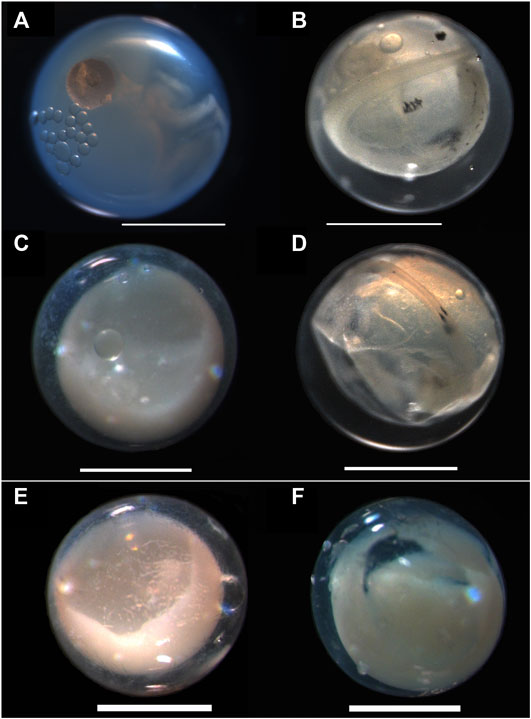
FIGURE 5. Photographs of three Trichiurus species eggs identified by COI: (A,B)T. japonicus; (C,D)T. nanhaiensis; (E,F)T. brevis.
Spawning Grounds and Hydrological Conditions
Eggs of Trichiurus in spring occurred mainly in the southern Beibu Gulf, along Hainan Island, and off the Pearl River Estuary; their densities in spring were higher than in late summer–autumn (Figure 7). In spring, eggs of T. japonicus occurred mainly in the middle-to-mouth of Beibu Gulf, and off the PRE, from 38.1 to 88.3 m, 25.4–28.5°C SST, and 32.2–34.6 salinity (Table 1; Figure 7). In late summer–autumn, eggs of T. japonicus were widely dispersed east of Hainan Island, but occurred nowhere in Beibu Gulf. In spring, eggs of T. nanhaiensis occurred in the same general areas as those of T. japonicus, but were found together at only one station. In late summer–autumn, eggs of T. nanhaiensis occurred at four stations at low density, over a wide depth range (55–380 m). In spring, eggs of T. brevis occurred at two stations, outside Beibu Gulf, and an inshore station in western coastal sea area of Guangdong, while during late summer–autumn, they occurred at four inshore stations (Figure 7). The horizontal distribution patterns of eggs of T. japonicus and T. nanhaiensis indicated by confocal ellipses with axes and slope are also shown in Figure 8. It is obvious that the spawning ground changed northeastward in late-summer-autumn in comparison to that in spring for T. nanhaiensis. However, for T. japonicus, the spawning ground off the PRE in spring changed southwestward and obviously enlarged in late-summer-autumn.
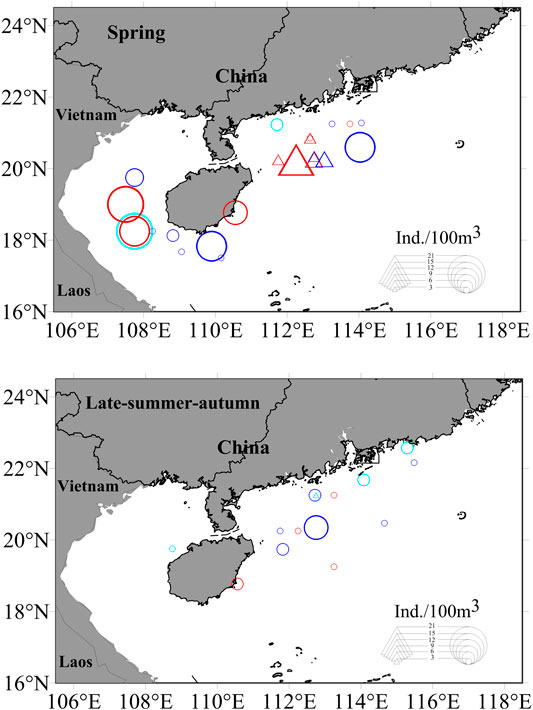
FIGURE 7. Distributions of eggs of three Trichiurus species in the northern South China Sea in spring and late-summer–autumn of 2019. Egg abundances: circles, horizontal; triangles, vertical. Red, T. nanhaiensis; blue T. japonicus; cyan T. brevis.
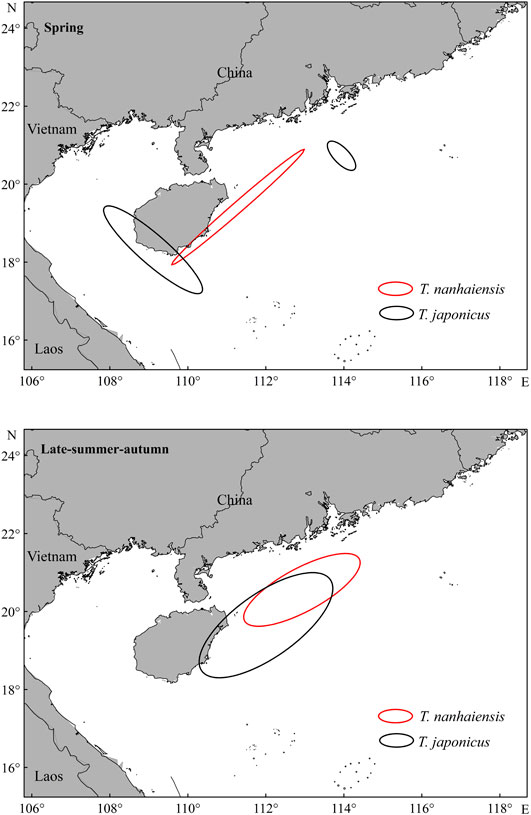
FIGURE 8. Horizontal distribution patterns of eggs of T. nanhaiensis and T. japonicus indicated by confocal ellipses of distribution areas, weighted by the density at each station, during spring and late-summer autumn in 2019.
The occurrence sites of Trichiurus eggs during spring and late summer–autumn of 2019 ranged 25.4–29.2°C SST and 32.4–34.6 salinity (Figures 2, 7), although in spring it was mainly 25.4–28.5°C SST and 33.5–34.6 salinity. Eggs of T. japonicus occurred over a wider salinity range than those of T. nanhaiensis or T. brevis. Hydrological requirments in which Trichiurus eggs occurred were observed to correlate with water mass conditions. Eggs of T. japonicus and T. nanhaiensis mainly occurred in the water masses of CSBGWM and SCSWM in spring, and occurred in SCSWM in late summer-autumn (Figures 3, 7). The salinity front restricted the spatial distribution along the coastal sea area of northern continental shelf of SCS (Figures 2B,D, 7). For T. brevis, eggs occurred one station in CSBGWM and the other station in EGCWM in spring, and occurred one coastal station in CSBGWM and three coastal stations in EGCWM along the salinity front, indicating different hydrological conditions for the spawning event.
Discussion
Molecular Identification and Egg Morphology
In the present study, we combined DNA barcoding (partial COI sequences) and morphology to unequivocally identify eggs of co-occurring Trichiurus species and their occurrence sites. Our eggs originated from samples taken during spawning-ground surveys conducted in spring and late summer–autumn of 2019 in the northern SCS. Most samples contained eggs of other species, which is not surprising given the high fish diversity in this area. A lack of detailed descriptions of fish eggs makes it difficult to identify them. Eggs of Trichiurus can be easily identified to family (Trichiuridae) in that they are spherical, similarly sized, have a smooth chorion, and a narrow perivitelline space.
Four species of Trichiurus (T. japonicus, T. lepturus, T. nanhaiensis, and T. brevis) occur in the SCS, but the early life stages are known for only T. haumela (as T. lepturus). While we found no eggs of T. lepturus in 2019, this species is supposedly rare in the northern SCS. We did, however, identify eggs of the three other species, which not only demonstrates the value and importance of DNA barcoding in fish egg identification, but for identifying spawning grounds of commercially important fish species also.
Egg Size Variation and Reproductive Strategies
The size of T. japonicus eggs in the SCS (1.65–2.21 mm) is greater than those from Japan (1.59–1.88 mm; Ikeda et al., 2015) and Korea (1.66–1.84 mm; Lee and Kim, 2014), suggesting regional variation. Because only T. hamela (as T. lepturus) was recognised from the SCS prior to the 1990s, we combine egg sizes of the three Trichiurus species we report from this region (1.59–2.21 mm) and compare them to T. hamela data from the SCS reported by SCSFRI (Institute, 1966) (1.61–1.83 mm) and Zhang et al. (1985) (1.50–1.90 mm). Eggs of Trichiurus in the SCS today appear to be larger than they were from the 1960s to 1980s.
We speculate that reproductive strategies of Trichiurus species have shifted in this region in response to changed oceanographic conditions or increased fishing pressure. The egg size-fecundity trade-off, and hypothesis that “bigger is better” for offspring fitness, regards larger maternal size to be preferable to produce larger offspring (Steiger, 2013). Had mature female fish size decreased in size because of fishing pressure, this combined with other environmental changes might result in production of smaller offspring, thereby reducing population biomass (Conover and Munch, 2002). However, Régnier et al. (2013) argued that bigger was not always better, because small brown trout (Salmo trutta) eggs can survive at higher rates than larger eggs throughout incubation (Chambers and Leggett, 1996; Régnier et al., 2013; Farmer et al., 2015; Neuheimer et al., 2015). Although size at hatching is directly correlated with egg size, and larger fish may produce larger eggs, the relationship between adult size and egg size among 309 North Atlantic fishes was weak (Chambers and Leggett, 1996). In subtropical to tropical waters of the northern SCS, T. japonicus and T. nanhaiensis might change reproductive strategy to produce larger eggs in response to fishery pressure and ocean warming, especially given both short and warm winter events in recent years. This may provide some insight into sharp declines in northern SCS stocks.
Spawning Ground Distributions and Hydrological Conditions
We describe the spatial and temporal distribution of T. japonicus, T. nanhaiensis and T. brevis eggs in the northern SCS in spring and late summer–autumn. DNA provides unequivocal evidence for T. brevis spawning in shallow waters, over seabed depths of 10.3–51.0 m, T. japonicus to spawn along the continental shelf over seabed depths of 38.1–118.0 m, and T. nanhaiensis to spawn along the continental shelf and slope over seabed depths of 42–380 m. Stations at which these three species co-occurred were rare (two stations in spring and one in late summer–autumn (Figure 7). Meanwhile, we found that the occurrence sites of T. japonicus eggs well matched the spatial and temporal distribution of the fishery resource in the surveyed seasons (Shi et al., 2020). It indicated that the egg distribution pattern can reflect the adult fish distribution and reproductive traits. In addition, the central spawning sea area of T. japonicus and T. nanhaiensis was east of Hainan Island, where a high catch rate of adult Japanese scad Decapterus maruadsi occurred (also the main spawning ground of this species (Institute, 1966). As D. maruadsi was the dominant prey (34% by weight) in stomachs of T. nanhaiensis, and second-most dominant prey in stomachs of T. lepturus (as T. japonicus now), both species likely fed during spawning, with prey availability inducing formation of spawning grounds (Yan et al., 2011; Yan et al., 2012).
Several studies have suggested that hydrological conditions, i.e., temperature, salinity and primary production were considered to significantly affect the occurrence and distribution patterns of ithchyoplankton (Hillgruber and Kloppmann, 1999; Franco-Gordo et al., 2002; Aceves-Medina et al., 2004; Lee and Go, 2005; de Macedo-Soares et al., 2014; Huang et al., 2017). In the present study, the eggs of Trichiurus were associated with specific water masses. In spring, eggs of T. japonicus and T. nanhaiensis occurred at CSBGWM and SCSWM. The SST in these two water masses increased earlier than other regions in the monsoon transition period, which were firstly affected by the southwest monsoon in the region (Figures 2A,C). In late summer-autumn, eggs of T. japonicus and T. nanhaiensis mainly occurred in the waters of SCSWM, south the salinity front (Figures 2C,D). The lower temperature sea and high salinity brought by Qiongdong upwelling have obviously benefited the spawning activities of the two speicies in the region. Meanwhile, the high temperature induced by strong southwest monsoon limit the spawning activity in the Beibu Gulf. Thus, we propose that the southwest monsoon promote the reproductive activities of T. japonicus and T. nanhaiensis in spring and restrict them in late summer-autumn.
Compared with a survey east of Hainan Island in 1964 in the same survey months (Institute, 1966), the spawning ground appears to have migrated west towards Qiongzhou Strait (19.8–21.0°N, 110.7–113°E), and south, away from the PRE. The coastal spawning habitat (<30 m) suitable for Trichiurus has degraded, corresponding with SST and salinity thresholds in spring (Table 1, Supplementary Figures S2, S3). Spawning ground shifts have been reported for other fish species also (e.g., Japanese sardine, Arctic and Atlantic cods, chub mackerel) as being induced by fisheries and climate change (Kikuchi et al., 1992; Van Der Meeren and Ivannikov, 2006; Opdal, 2010; Kanamori et al., 2019). Throughout the SCS, average SST has increased by about 0.348°C from 1982 to 2010, and has been projected to increase by about 0.36°C over 9 decades from 2010 to 2,100 (Atkinson et al., 2016). The annual mean SST in the central SCS has increased by 0.92°C from 1950 to 2006 (Cai et al., 2009). In continental shelf shallow waters (0–200 m) in the northern SCS that we surveyed, average SST increases may be greater.
Ocean warming can result in fishes shifting their distributions to higher latitudes, and local biodiversity loss. This can change the composition of fisheries, shift spawning grounds, and even increase the possibility of natural hybridisation (Perry et al., 2005; Peter et al., 2011; Cheunge et al., 2013; Neira et al., 2015; Verges et al., 2016; Kanamori et al., 2019; Takahashi et al., 2020). High temperatures can also lead to physiological changes in reproduction, with male fishes raised at stressful temperatures having shorter, slower sperm than fishes raised at more benign temperatures, decreasing fertilisation rates and affecting recruitment (Breckels and Neff, 2013). The tendency for Trichiurus eggs to concentrate in eastern areas of Qiongzhou Strait (110.7–113°E) may be an adaption to oceanic environmental change. Changes in distributions of eggs shall cause the attention in the fish protection and fishery management.
Fishery Conservation and Management
Because of coastal habitat degradation and/or loss, coupled with over-fishing, fishery resources have declined. A pressing need exists to protect these fish resources and improve fishery management in the northern SCS (Qiu, 2002). The timing of spawning seasons and locations of spawning grounds are key parameters in fishery management strategies. Using DNA barcodes, we identify eggs of specific fish species and demonstrate how this technology can assist with morphological identifications of eggs in spawning ground surveys. Meanwhile, under the background of ocean warming, potential shift spawning grounds may occur under the change of hydrological conditions. Our study provides important information on spawning ground areas that can be used to advance their protection, and how adjusting the timing of fishing moratoria in the SCS can facilitate sustainable fisheries management.
Data Availability Statement
The datasets presented in this study can be found in online repositories. The names of the repository/repositories and accession number(s) can be found below: NCBI [accession: MT762604- MT762679]
Ethics Statement
The animal study was reviewed and approved by the South China Sea Fisheries Research Institute, Chinese Academy of Fishery Science.
Author Contributions
GH and ZC analyzed the data and completed the first draft. GH, YX, and JW performed the field survey. GH, WH, JW and JZ conducted the experiments. KZ and ZC provided the guidance on data analysis and structure. All authors contributed to the article and approved the submitted version.
Funding
This study was supported by the key research and development project of Guangdong Province (2020B1111030001), the Natural Science Foundation of China (NSFC, No.31702347), Guangdong major project of basic and applied basic research (2019B030302004), undergraduate innovation and Entrepreneurship training program of Guangdong province (S202010566005), and the start-up project of Guangdong Ocean University (R19006).
Conflict of Interest
The authors declare that the research was conducted in the absence of any commercial or financial relationships that could be construed as a potential conflict of interest.
Publisher’s Note
All claims expressed in this article are solely those of the authors and do not necessarily represent those of their affiliated organizations, or those of the publisher, the editors and the reviewers. Any product that may be evaluated in this article, or claim that may be made by its manufacturer, is not guaranteed or endorsed by the publisher.
Acknowledgments
We would like to thank numerous colleagues for their generous support of this study, the crew members of Zhongyuke 301 and Beiyu 60011, and all the survey ships for their help.
Supplementary Material
The Supplementary Material for this article can be found online at: https://www.frontiersin.org/articles/10.3389/fenvs.2021.703029/full#supplementary-material
References
Aceves-Medina, G., Jiménez-Rosenberg, S. P. A., Hinojosa-Medina, A., Funes-Rodriguez, R., Saldierna-Martinez, R. J., and Smith, P. E. (2004). Fish Larvae Assemblages in the Gulf of California. J. Fish Biol. 65, 832–847. doi:10.1111/j.1095-8649.2004.00490.x
Atkinson, P. M., Challenor, P., and Idham, K. (2016). Looking Back and Looking Forwards: Historical and Future Trends in Sea Surface Temperature (SST) in the Indo-Pacific Region from 1982 to 2100. Int. J. Appl. Earth Obs. Geoinf. 45, 14–26. doi:10.1016/j.jag.2015.10.005
Breckels, R. D., and Neff, B. D. (2013). The Effects of Elevated Temperature on the Sexual Traits, Immunology and Survivorship of a Tropical Ectotherm. J. Exp. Biol. 216, 2658–2664. doi:10.1242/jeb.084962
Cai, R., Zhang, Q., and Qi, Q. (2009). Spatial and Temporal Oscillation and Long-Term Variation in Sea Surface Temperature Field of the South China Sea. J. Oceanogr. Taiwan. Stra. 4, 559–568. doi:10.3969/J.ISSN.1000-8160.2009.04.020
Chakraborty, A., Aranishi, F., and Iwatsuki, Y. (2006). Genetic Differentiation of Trichiurus Japonicus and T. Lepturus (Perciformes: Trichiuridae) Based on Mitochondrial DNA Analysis. Zool.Stud. 45, 419–427.
Chambers, R. C., and Leggett, W. C. (1996). Maternal Influences on Variation in Egg Sizes in Temperate marine Fishes. Am. Zool. 36, 180–196. doi:10.1093/icb/36.2.180
Chambers, R. C., and Trippel, E. A. (1997). “Early Life History and Recruitment: Legacy and Challenges,” in Early Life History and Recruitment in Fish Populations (London: Chapman and Hall), 515–549. doi:10.1007/978-94-009-1439-1_19
Chang, C.-H., Shao, K.-T., Lin, H.-Y., Chiu, Y.-C., Lee, M.-Y., Liu, S.-H., et al. (2017). DNA Barcodes of the Native ray-finned Fishes in Taiwan. Mol. Ecol. Resour. 17, 796–805. doi:10.1111/1755-0998.12601
Checkley, D., Alheit, J., Oozeki, Y., and Roy, C. (2009). Climate Change and Small Pelagic Fish. Cambridge: Cambridge University Press. doi:10.1017/CBO9780511596681
Chen, G. B., Li, Y. Z., and Chen, P. M. (2003). A Study on Spawning Ground of Blue Mackerel Scad (Decapterus Maruadsi) in continental Shelf Waters of Northern South China Sea. J. Trop. Oceanogr., 22–28.
Chen, L.-C., Lan, K.-W., Chang, Y., and Chen, W.-Y. (2018). Summer Assemblages and Biodiversity of Larval Fish Associated with Hydrography in the Northern South China Sea. Mar. Coast Fish. 10, 467–480. doi:10.1002/mcf2.10037
Cheung, W. W. L., Watson, R., and Pauly, D. (2013). Signature of Ocean Warming in Global Fisheries Catch. Nature 497, 365–368. doi:10.1038/nature12156
China Agriculture Press (1997-2019). China Fishery Statistical Yearbook in 1997-2019. (Beijing: China Agriculture Press).
Conover, D. O., and Munch, S. B. (2002). Sustaining Fisheries Yields over Evolutionary Time Scales. Science 297, 94–96. doi:10.1126/science.1074085
de Macedo-Soares, L. C. P., Garcia, C. A. E., Freire, A. S., and Muelbert, J. H. (2014). Large-scale Ichthyoplankton and Water Mass Distribution along the South Brazil Shelf. PLoS One 9, e91241. doi:10.1371/journal.pone.0091241
Farmer, T. M., Marschall, E. A., Dabrowski, K., and Ludsin, S. A. (2015). Short winters Threaten Temperate Fish Populations. Nat. Commun. 6, 1–10. doi:10.1038/ncomms8724
Franco-Gordo, C., Godínez-Domínguez, E., and Suárez-Morales, E. (2002). Larval Fish Assemblages in Waters off the central pacific Coast of mexico. J. Plankton Res. 24, 775–784. doi:10.1093/plankt/24.8.775
Frantine-Silva, W., Sofia, S. H., Orsi, M. L., and Almeida, F. S. (2015). DNA Barcoding of Freshwater Ichthyoplankton in the Neotropics as a Tool for Ecological Monitoring. Mol. Ecol. Resour. 15, 1226–1237. doi:10.1111/1755-0998.12385
Fuiman, L. A. (2002). “Special Considerations of Fish Eggs and Larvae,” in Fishery Science, the Unique Contributions of Early Life Stages. Editors L. A. Fuiman, and R. G. Werner. (Oxford: Blackwell Science), 1–32. doi:10.1577/1548-8659(2003)132<1033a:BR>2.0.CO;2
He, L., Zhang, A., Weese, D., Li, S., Li, J., and Zhang, J. (2014). Demographic Response of Cutlassfish (Trichiurus Japonicus and T. Nanhaiensis) to Fluctuating Palaeo-Climate and Regional Oceanographic Conditions in the China Seas. Sci. Rep. 4, 1–10. doi:10.1038/srep06380
Hillgruber, N., and Kloppmann, M. (1999). Distribution and Feeding of Blue whiting Micromesistius Poutassou Larvae in Relation to Different Water Masses in the Porcupine Bank Area, West of ireland. Mar. Ecol. Prog. Ser. 187, 213–225. doi:10.3354/meps187213
Hou, G., Chen, W.-T., Lu, H.-S., Cheng, F., and Xie, S.-G. (2018). Developing a DNA Barcode Library for Perciform Fishes in the South China Sea: Species Identification, Accuracy and Cryptic Diversity. Mol. Ecol. Resour. 18, 137–146. doi:10.1111/1755-0998.12718
Hsu, K. C., Shih, N. T., Ni, I. H., and Shao, K. T. (2009). Speciation and Population Structure of Three Trichiurus Species Based on Mitochondrial DNA. Zool. Stud. 48, 851–865.
Huang, D., Zhang, X., Jiang, Z., Zhang, J., Arbi, I., Jiang, X., et al. (2017). Seasonal Fluctuations of Ichthyoplankton Assemblage in the Northeastern S Outh C Hina S Ea Influenced by the K Uroshio Intrusion. J. Geophys. Res. Oceans 122, 7253–7266. doi:10.1002/2017JC012906
Hubert, N., Espiau, B., Meyer, C., and Planes, S. (2015). Identifying the Ichthyoplankton of a Coral Reef Using DNA Barcodes. Mol. Ecol. Resour. 15, 57–67. doi:10.1111/1755-0998.12293
Ikeda, S, M., S, T., Y, O., and S, M. (2015). “Key to Fish Eggs in Japan,” in An Atlas of the Early Stage Fishes in Japan. Editor M. Okiyama. Second Edition (Kanagawa: Tokai University Press), 1–108.
Institute, S. C. S. F. R. (1966). The Investigation Report of Fishery Resources by Bottom Trawl Survey in Northern South China Sea, 98–136.
Kanamori, Y., Takasuka, A., Nishijima, S., and Okamura, H. (2019). Climate Change Shifts the Spawning Ground Northward and Extends the Spawning Period of Chub Mackerel in the Western North Pacific. Mar. Ecol. Prog. Ser. 624, 155–166. doi:10.3354/meps13037
Kikuchi, H., Mori, K., and Nakata, K. (1992). Offshore Shift of the Spawning Ground of Japanese Sardine(in the Waters East of Cape Shionomisaki, along the Paciffic Coast of Central Japan). Nippon Suisan Gakkaishi 58, 427–432. doi:10.2331/suisan.58.427
Kim, J.-Y., Kang, Y.-S., Oh, H.-J., Suh, Y.-S., and Hwang, J.-D. (2005). Spatial Distribution of Early Life Stages of Anchovy (Engraulis japonicus) and Hairtail (Trichiurus Lepturus) and Their Relationship with Oceanographic Features of the East China Sea during the 1997-1998 El Niño Event. Estuarine, Coastal Shelf Sci. 63, 13–21. doi:10.1016/j.ecss.2004.10.002
Kimura, M. (1980). A Simple Method for Estimating Evolutionary Rates of Base Substitutions through Comparative Studies of Nucleotide Sequences. J. Mol. Evol. 16, 111–120. doi:10.1007/BF01731581
Kwok, K., and Ni, I. (1999). Reproduction of Cutlassfishes Trichiurus Spp. From the South China Sea. Mar. Ecol. Prog. Ser. 176, 39–47. doi:10.3354/meps176039
Lee, S.-J., and Go, Y.-B. (2005). Occurrence and Distribution of the Eggs and Larvae of Anchovy, Engraulis japonicus, in Jeju Strait, Korea, with Descriptions of Environmental Characteristics. J. Oceanogr. 61, 603–611. doi:10.1007/s10872-005-0068-5
Lee, S. J., and Kim, J.-K. (2014). Identification of Trichiurus (Pisces: Trichiuridae) Eggs and Larvae from Korea, with a Taxonomic Note. Fish. Aquat. Sci. 17, 137–143. doi:10.5657/FAS.2014.0137
Lei, L. I., Qi, L. F., Jie, S. U., and Jian, X. U. (2002). Analysis on Water Masses in the south china Sea in Summer and winter of 1998. Oceanolo. Limnol. Sin. 33, 393–401.
Li, K., Yin, J., Huang, L., and Lin, Z. (2014). Seasonal Variations in Diversity and Abundance of Surface Ichthyoplankton in the Northern South China Sea. Acta Oceanol. Sin. 33, 145–154. doi:10.1007/s13131-014-0533-3
Liu, Z. H., Li, L., Xu, J. P., and Shi, M. C. (2001). Analysis of Water Masses in the South China Sea in the Summer of 1998. Donghai Mar. Sci. 03, 2–11.
Lu, H., Yan, Y., and Hou, G. (2008). Report of Investigation and Survey on the Beibu Gulf Fisheries Resources. Zhanjiang: Guangdong Ocean University.
Myers, N., Mittermeier, R. A., Mittermeier, C. G., Da Fonseca, G. A. B., and Kent, J. (2000). Biodiversity Hotspots for Conservation Priorities. Nature 403, 853–858. doi:10.1038/35002501
Neira, F. J., Perry, R. A., Burridge, C. P., Lyle, J. M., and Keane, J. P. (2015). Molecular Discrimination of Shelf-Spawned Eggs of Two Co-occurring Trachurus Spp. (Carangidae) in southeastern Australia: a Key Step to Future Egg-Based Biomass Estimates. ICES J. Mar. Sci. 72, 614–624. doi:10.1093/icesjms/fsu151
Neuheimer, A. B., Hartvig, M., Heuschele, J., Hylander, S., Kiørboe, T., Olsson, K. H., et al. (2015). Adult and Offspring Size in the Ocean over 17 Orders of Magnitude Follows Two Life History Strategies. Ecology 96, 3303–3311. doi:10.1890/14-2491.1
Opdal, A. F. (2010). Fisheries Change Spawning Ground Distribution of Northeast Arctic Cod. Biol. Lett. 6, 261–264. doi:10.1098/rsbl.2009.0789
Perry, A. L., Low, P. J., Ellis, J. R., and Reynolds, J. D. (2005). Climate Change and Distribution Shifts in marine Fishes. Science 308, 1912–1915. doi:10.1126/science.1111322
Peter, R. L., White, W. T., Gledhill, D. C., Hobday, A. J., Brown, R., Edgar, G. J., et al. (2011). Long-term Shifts in Abundance Anddistribution of a Temperate Fish Fauna:a Response to Climate Change and Fishing Practices. Glob. Ecol. Biogeogr. 20, 58–72. doi:10.1111/j.1466-8238.2010.00575.x
Qiu, Y. S. (2002). “Fishery Resource Status and Its Rational Utilization Strategy in the northern South China Sea,” in Proceedings on China’s Exclusive Economic Zone and Continental Shelf Survey. (Beijing: Marine Press), 360–367.
Ratnasingham, S., and Hebert, P. D. (2007). Bold: The Barcode of Life Data System. Mol. Eco. Not. 7, 355–364. doi:10.1111/j.1471-8286.2007.01678.x
Régnier, T., Bolliet, V., Gaudin, P., and Labonne, J. (2013). Bigger Is Not Always Better: Egg Size Influences Survival throughout Incubation in Brown trout (Salmo trutta). Ecol. Freshw. Fish. 22, 169–177. doi:10.1111/eff.12018
Shao, K.-T., Chen, K.-C., and Wu, J.-H. (2002). Identification of marine Fish Eggs in Taiwan Using Light Microscopy, Scanning Electric Microscopy and mtDNA Sequencing. Mar. Freshw. Res. 53, 355–365. doi:10.1071/MF01141
Shi, D. F., Zhang, K., Cai, Y. S., Geng, P., Xu, Y. W., Sun, M. S., et al. (2020). Population Structure of Trichiurus Japonicus in Northern South China Sea and Parameters of its Growth, Mortality and Maturity. South. China Fish. Sci. 16, 51–59. doi:10.12131/20200055
Sokal, R. R., and Rohlf, F. J. (1995). Biometry:The Principles and Practice of Statistics in Biological Research. 3rd ed. New York: W.H. Freeman and Company, 859.
Steiger, S. (2013). Bigger Mothers Are Better Mothers: Disentangling Size-Related Prenatal and Postnatal Maternal Effects. Proc. R. Soc. B. 280, 20131225. doi:10.1098/rspb.2013.1225
Sun, D. R., and Chen, Z. (2013). Fish Categories Books in the South China Sea: Volume One. Beijing: Maritime Press.
Takahashi, H., Kurogoushi, T., Shimoyama, R., and Yoshikawa, H. (2020). First Report of Natural Hybridization between Two Yellowtails, Seriola quinqueradiata and S. lalandi. Ichthyol. Res. 68, 139–144. doi:10.1007/s10228-020-00752-8
Tamura, K., Stecher, G., Peterson, D., Filipski, A., and Kumar, S. (2013). MEGA6: Molecular Evolutionary Genetics Analysis Version 6.0. Mol. Bio. Evo. 30, 2725–2729. doi:10.1093/molbev/mst197
Tzeng, C.-H., and Chiu, T.-S. (2012). DNA Barcode-Based Identification of Commercially Caught Cutlassfishes (Family: Trichiuridae) with a Phylogenetic Assessment. Fish. Res. 127–128, 176–181. doi:10.1016/j.fishres.2012.01.022
Tzeng, C. H., Chen, C. S., and Chiu, T. S. (2007). Analysis of Morphometry and Mitochondrial DNA Sequences from Two Trichiurus Species in Waters of the Western North Pacific: Taxonomic Assessment and Population Structure. J. Fish. Biol. 70, 165–176. doi:10.1111/j.1095-8649.2007.01368.x
Valdez-Moreno, M., Vásquez-Yeomans, L., Elías-Gutiérrez, M., Ivanova, N. V., and Hebert, P. D. N. (2010). Using DNA Barcodes to Connect Adults and Early Life Stages of marine Fishes from the Yucatan Peninsula, Mexico: Potential in Fisheries Management. Mar. Freshw. Res. 61, 655–671. doi:10.1071/MF09222
Van Der Meeren, T., and Ivannikov, V. P. (2006). Seasonal Shift in Spawning of Atlantic Cod (Gadus morhua L.) by Photoperiod Manipulation: Egg Quality in Relation to Temperature and Intensive Larval Rearing. Aquaculture Res 37, 898–913. doi:10.1111/j.1365-2109.2006.01510.x
Vergés, A., Doropoulos, C., Malcolm, H. A., Skye, M., Garcia-Pizá, M., Marzinelli, E. M., et al. (2016). Long-term Empirical Evidence of Ocean Warming Leading to Tropicalization of Fish Communities, Increased Herbivory, and Loss of Kelp. Proc. Natl. Acad. Sci. USA 113, 13791–13796. doi:10.1073/pnas.1610725113
Wang, H.-Y., Dong, C. A., and Lin, H.-C. (2017). DNA Barcoding of Fisheries Catch to Reveal Composition and Distribution of Cutlassfishes along the Taiwan Coast. Fish. Res. 187, 103–109. doi:10.1016/j.fishres.2016.11.015
Wang, K. (1993). Studies on the Genetic Variation and Systematic of the Hairtails Fishes from South China Sea. Acta Oceanol. Sin. 15, 77–83.
Wang, K. (1992). Studies on the Genetic Variation and Systematics of the Hairtail Fishes from the South China Sea. Mar. Sci. Acadcmia Sinica (Beijing) 2, 69–72.
Wang, K., Zhang, P., Liu, L., You, F., and Xu, C. (1993). Studies on Trichiuridae from China Coastal Water. Acta Oceanol. Sin. 15, 77–85.
Wang, K., Zhang, P., Liu, L., You, F., Xu, C., and Wang, J. (1994). Biochemical Assessment of the Taxonomic Status of Trichiuridae Population from China Coastal Water. Acta Oceanol. Sin. 16, 93–104.
Ward, R. D., Zemlak, T. S., Innes, B. H., Last, P. R., and Hebert, P. D. N. (2005). DNA Barcoding Australia's Fish Species. Phil. Trans. R. Soc. B 360, 1847–1857. doi:10.1098/rstb.2005.1716
Yan, Y., Chen, J., Lu, H., Hou, G., and Lai, J. (2012). Feeding Habits and Ontogenetic Diet Shifts of Hairtail, Trichiurus Margarites, in the Beibu Gulf of the South China Sea. Acta Ecologica Sinica 32, 18–25. doi:10.1016/j.chnaes.2011.04.008
Yan, Y., Hou, G., Chen, J., Lu, H., and Jin, X. (2011). Feeding Ecology of Hairtail Trichiurus Margarites and Largehead Hairtail Trichiurus Lepturus in the Beibu Gulf, the South China Sea. Chin. J. Ocean. Limnol. 29, 174–183. doi:10.1007/s00343-011-0004-z
Ye, Y., and Rosenberg, A. A. (1991). A Study of the Dynamics and Management of the Hairtail fishery,Trichiurus Haumela, in the East China Sea. Aquat. Living Resour. 4, 65–75. doi:10.1051/alr:1991007
Zhang, R., Lu, S., Zhao, C., Chen, L., Zang, Z., and Zhang, X. (1985). Fish Eggs and Larvae in the Offshore Waters of China. Shanghai: Shanghai Scientific and Technological Press.
Zhou, M., Lin, Y., Yang, S., Cao, W., and Zheng, L. (2011). Composition and Ecological Distribution of Ichthyoplankton in Eastern Beibu Gulf. Acta Oceanol. Sin. 30, 94–105. doi:10.1007/s13131-011-0095-6
Keywords: Trichiurus spp., fish eggs, DNA barcode, spawning ground, hydrological characteristic, northern South China Sea
Citation: Hou G, Xu Y, Chen Z, Zhang K, Huang W, Wang J and Zhou J (2021) Identification of Eggs and Spawning Zones of Hairtail Fishes Trichiurus (Pisces: Trichiuridae) in Northern South China Sea, Using DNA Barcoding. Front. Environ. Sci. 9:703029. doi: 10.3389/fenvs.2021.703029
Received: 30 April 2021; Accepted: 20 July 2021;
Published: 06 August 2021.
Edited by:
Chao Song, Chinese Academy of Fishery Sciences, ChinaReviewed by:
José M. A. Jesus, University of Madeira, PortugalBilin Liu, Shanghai Ocean University, China
Copyright © 2021 Hou, Xu, Chen, Zhang, Huang, Wang and Zhou. This is an open-access article distributed under the terms of the Creative Commons Attribution License (CC BY). The use, distribution or reproduction in other forums is permitted, provided the original author(s) and the copyright owner(s) are credited and that the original publication in this journal is cited, in accordance with accepted academic practice. No use, distribution or reproduction is permitted which does not comply with these terms.
*Correspondence: Zuozhi Chen, Y2hlbnp1b3poaUBzY3NmcmkuYWMuY24=
 Gang Hou
Gang Hou Youwei Xu2,3,4
Youwei Xu2,3,4 Zuozhi Chen
Zuozhi Chen Kui Zhang
Kui Zhang Wangsu Huang
Wangsu Huang Jinrun Wang
Jinrun Wang Jinlong Zhou
Jinlong Zhou